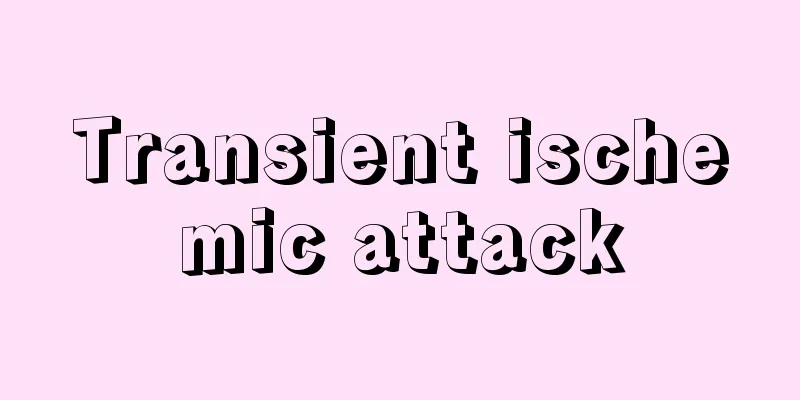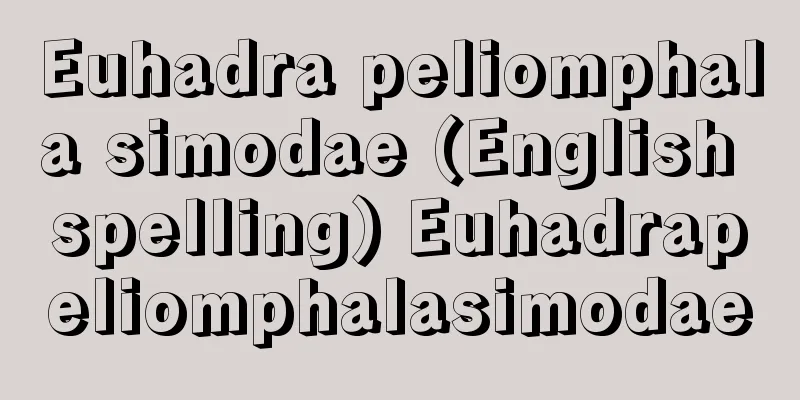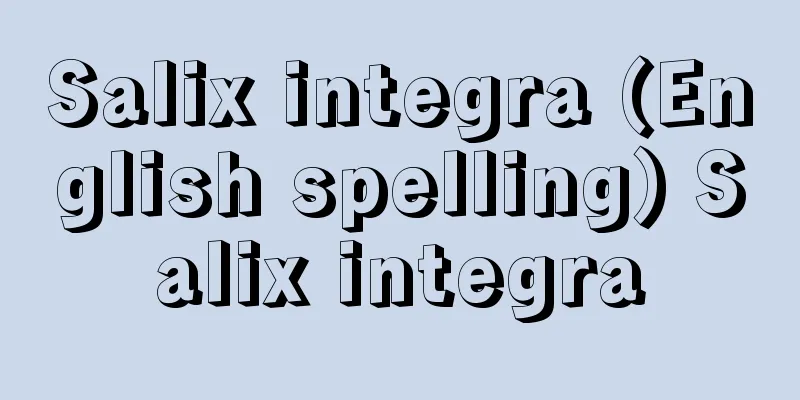Transient ischemic attack

|
Definition and Concept According to the 1990 National Institute of Neurological Disorders and Stroke Classification, 3rd Edition (NINDS-III), a transient ischemic attack is a brief attack that usually presents local neurological symptoms in a single cerebral vascular perfusion territory (the right and left carotid arteries and the vertebral basilar artery territory), and is unlikely to be caused by anything other than cerebral ischemia. Therefore, when using transient ischemic attack as a diagnostic name, it should be limited to those with local cerebral ischemic symptoms, and should not include transient global cerebral ischemia caused by a drop in blood pressure. Symptoms usually resolve within 2-5 minutes, last for 2-15 minutes, and often resolve rapidly, but for convenience, those that recover without sequelae within 24 hours are called transient ischemic attacks. The NINDS-III classification states that the longer the attack lasts, the more likely it is that an infarct will be found on CT or MRI, and that it is important to prevent subsequent cerebral infarction without focusing on the presence or absence of cerebral infarction on images. A new definition of transient ischemic attack (TIA) was proposed by the American Stroke Association in 2009: "a transient neurological deficit resulting from focal cerebral ischemia, spinal cord ischemia, or retinal ischemia, without the occurrence of acute cerebral infarction." Regardless of the duration of symptoms, emphasis is placed on the presence or absence of infarction by diagnostic imaging (Easton et al., 2009). As for the etiological mechanism of the disease , various theories have been proposed, including the microembolism theory, the hemodynamic theory, and the cerebral vasospasm theory. Currently, based on studies using ultrasound Doppler techniques, it is predominantly believed that the majority of cases are caused by artery-to-artery microemboli, but there are also quite a few cases caused by hemodynamic abnormalities, cardiogenic embolism, and hematological abnormalities. 1) Microembolism hypothesis: Atherosclerotic lesions (plaques) that occur at the origin of the internal carotid artery often rupture to form ulcers, which are prone to platelet thrombi. When these mural thrombi detach, they become microemboli that occlude small peripheral blood vessels in the brain, causing localized neurological symptoms, but they are thought to disintegrate and dissolve within a short period of time, resulting in recovery from the symptoms. The significant effect of antiplatelet therapy in preventing the recurrence of transient ischemic attacks is also a major basis for this theory. 2) Hemodynamic theory: When stenosis or occlusion is present in the major cerebral arteries, cerebral perfusion pressure decreases, but cerebral blood flow is usually maintained by collateral circulation and symptoms do not appear immediately. However, if systemic blood pressure falls for some reason or there is a disorder in the autoregulation of cerebral circulation, it is thought that cerebral vascular insufficiency can easily occur in areas where perfusion was maintained by collateral circulation, and local symptoms appear transiently. In particular, in cases of occlusion of the circle of Willis (moyamoya disease), blood flow to the anterior half of the brain is maintained by collateral circulation due to occlusion of the terminal parts of both internal carotid arteries, but during hyperventilation, blood flow cannot be maintained due to cerebral vasoconstriction, resulting in a transient ischemic attack. Epidemiology In Europe and the United States, transient ischemic attacks precede atherothrombotic cerebral infarction in 25-50% of cases, cardiogenic cerebral embolism in 11-30% of cases, and lacunar infarction in 11-14% of cases. According to statistics from Japan in 2000, transient ischemic attacks accounted for 6.4% of all ischemic strokes. Clinical symptoms are diverse, and most of the neurological symptoms that appear in normal cerebral infarction can also appear in transient ischemic attacks. The main symptoms of transient ischemic attacks are shown in Table 15-5-5. Symptoms differ between the internal carotid artery system and the vertebral artery system. Of these symptoms, dysarthria and homonymous hemianopsia require special attention as they can occur in either system. In addition, amaurosis fugax is a symptom of the same side of the internal carotid artery system and usually occurs alone, but its frequency in Japan is said to be lower than in Europe and the United States. Seizures known as limb shaking TIA, in which the upper limbs tremble irregularly, are also known as symptoms of the internal carotid artery system and must be distinguished from epileptic seizures. It is said that 80% of transient ischemic attacks are of the internal carotid artery system and 20% are of the vertebral artery system. Table 15-5-6 shows the symptoms of atypical transient ischemic attacks and non-transient ischemic attacks as listed in the NINDS-III classification. Clinically, it is essential not to overlook transient ischemic attacks as a precursor to cerebral infarction, and it is not possible to make a definitive diagnosis, but it is important to carefully observe cases in which there is still a possibility of a transient ischemic attack as a possible TIA. Diagnosis: Prompt diagnosis and evaluation are necessary because a delay in diagnosis of a transient ischemic attack increases the risk of progression to cerebral infarction. It is rare for a doctor to be present during an attack, so a detailed medical history is essential for diagnosis. A neck bruit indicates carotid artery stenosis, while a retinal vascular embolism or a difference in brachial artery blood pressure of 15 mmHg or more between the left and right sides suggests a large vessel lesion. In imaging diagnosis, lesions are found in 32% of cases of transient ischemic attack by head CT and 77% by MRI. It is also important to check for extracranial vascular lesions by neck ultrasound, but intracranial arteriosclerotic lesions are relatively common in Japan, so it is also necessary to confirm the presence or absence of intracranial vascular stenosis by magnetic resonance angiography (MRA). If vascular stenosis is found, angiography should be performed as necessary, followed by cerebral blood flow tests using single photon emission CT (SPECT) or Xe-CT, and a check for nocturnal blood pressure drop using 24-hour blood pressure monitoring (ABPM). On the other hand, if cardiogenic cerebral embolism is suspected, Holter electrocardiography, transthoracic or transesophageal echocardiography, etc. should be performed. In addition, in young people and other individuals who do not have any particular risk factors for arteriosclerosis, special coagulation system tests are performed. Differential diagnosis: migraine (typical and hemiplegic) and epilepsy should be considered. Organic brain lesions include brain tumors, chronic subdural hematomas, vascular malformations, and multiple sclerosis. Other examples include transient global amnesia, Ménière syndrome, syncope (and presyncope state) due to hypotension, hyperventilation syndrome, hypoglycemia, narcolepsy, catalepsy, hysteria, and periodic paralysis. Transient monocular symptoms may be accompanied by giant cell arteritis, malignant hypertension, glaucoma, papilledema, and nonvascular lesions of the orbit and retina. Course and prognosis Transient ischemic attacks are considered to be a precursor to cerebral infarction, and it is said that about one-third of cases progress to complete cerebral infarction. In particular, the incidence is highest in the early stages after a transient ischemic attack. In particular, so-called crescendo TIA, in which the frequency of attacks increases, is often caused by severe stenosis of the internal carotid artery, and often progresses to complete cerebral infarction. The ABCD 2 score is used as a measure to predict the risk of cerebral infarction after a TIA. It is assessed using the following total points: age: age 60 years or older (1 point), blood pressure: hypertension (systolic blood pressure > 140 mmHg or diastolic blood pressure ≥ 90 mmHg) (1 point), clinical features: clinical symptoms; unilateral weakness (2 points), speech disorder without weakness (1 point), duration: duration ≥ 60 minutes (2 points), 10-59 minutes (1 point), and diabetes: diabetes (1 point). The risk of stroke within 2 days after a TIA is 1.0% for an ABCD 2 score of 0-3, 4.1% for 4-5, and 8.1% for 6-7, with the higher the score, the higher the risk of stroke (Johnston et al., 2007). Hospitalization is recommended for patients with an ABCD 2 score of 4 or more. In addition, reports have shown that if atrial fibrillation or carotid artery stenosis is present, the risk of developing cerebral infarction is high even if the ABCD 2 score is less than 4, so hospitalization for treatment is recommended. Treatment and Prevention 1) Identifying and managing risk factors: The progression of arteriosclerosis is closely related to the onset of transient ischemic attacks, so it is important to identify and correct these risk factors. Important measures include managing hypertension, quitting smoking, managing coronary disease, arrhythmia, heart failure, and valvular heart disease, managing diabetes, managing hyperlipidemia, drinking less (less than 30 g of alcohol per day), moderate exercise (30-60 minutes at least 3-4 times per week), and controlling weight (less than 120% of ideal weight) (Albers et al., 1999). 2) Medical treatment: a) Antiplatelet therapy: Antiplatelet drugs are recommended for non-cardiogenic TIA. In the acute phase, aspirin 160-300 mg/day is appropriate as initial treatment, while in the chronic phase, aspirin 75-150 mg/day, clopidogrel 75 mg/day, and cilostazol 200 mg/day are appropriate. The choice of antiplatelet drug is based on the patient's risk factors, cost, tolerance, and clinical characteristics. b) Anticoagulant therapy: In TIA thought to be caused by cardiogenic embolism, anticoagulant therapy should be initiated as early as possible. Heparin should be adjusted to increase the partial thromboptastin (APTT) by 1.5 to 2 times. When switching to warfarin, an overlap period of 4 to 5 days is usually allowed until the prothrombin time INR (international normalized ratio) reaches 2 to 3 (1.6 to 2.6 in elderly patients). In TIA thought to be caused by non-valvular atrial fibrillation, it is possible to start oral administration of dabigatran or rivaroxaban without using heparin. Anticoagulant therapy is also indicated in cresendo TIA due to hemodynamic mechanisms, as increased coagulation at low flow rates is thought to be involved. 3) Surgical treatment: Carotid endarterectomy (CEA) is indicated for TIA caused by carotid artery lesions with a stenosis rate of 70% or more. When the stenosis rate is 50-69%, CEA should be considered taking into account age, sex, comorbidities, etc. When the stenosis rate is less than 50%, CEA and carotid artery stenting (CAS) are not recommended. In patients with a high risk of CEA, such as those with cardiac disease or elderly, CAS should be performed by an appropriate surgeon. When a TIA occurs due to internal carotid artery occlusion or middle cerebral artery occlusion or stenosis, the suitability of extracranial-intracranial bypass surgery must be carefully considered, including resting cerebral blood flow and cerebrovascular reactivity tests. [Tanahashi Norio] ■ References Albers GW, Hart RG, et al: Supplement to the guidelines for the management of transient ischemic attacks. A statement from the Ad Hoc Committee on Guidelines for the management of transient ischemic attacks, stroke council, American Heart Association. Stroke, 30: 2502-2511, 1999. Easton JD, Saver JL, et al: Definition and evaluation of transient ischemic attack: a scientific statement for healthcare profrssionals from the American Heart Association/American Stroke Association Stroke Council on Cardiovascular Surgery and Anesthesia; Council on Cardiovascular Nursing; and the Interdisciplinary Council on Peripheral Vascular Disease. Stroke, 40: 2276-2293, 2009. Johnson SC, Rothwell PM, et al: Validation and refinement of scores to predict very early stroke risk after transient ischaemic attack. Lancet, 369 : 283-292, 2007. Major symptoms of transient ischemic attack (NINDS classification, 1990) Table 15-5-5 Atypical Transient Ischemic Attack, Non-Transient Ischemic Attack Symptoms (NINDS Classification, 1990) "> Table 15-5-6 Source : Internal Medicine, 10th Edition About Internal Medicine, 10th Edition Information |
|
定義・概念 一過性脳虚血発作とは,1990年の米国国立神経疾患・脳卒中研究所による脳卒中の分類第3版(NINDS-Ⅲ)によれば,通常単一の脳血管灌流領域(左右頸動脈,椎骨脳底動脈領域)における局所神経症状を呈する短時間の発作で,脳虚血以外の原因が考えにくいものである.したがって,一過性脳虚血発作を診断名として用いる場合には局所脳虚血症状を認めたものに限定され,血圧低下による一過性全脳虚血を含めるべきでない.症状は通常2~5分以内に完成し,2~15分間持続し急速に寛解することが多いが,便宜上24時間未満に後遺症を残さず回復するものを一過性脳虚血発作とよぶ.NINDS-Ⅲ分類では,発作の持続が長いほどCT,MRIで梗塞巣が発見される可能性が高いとし,画像上の脳梗塞の有無には固執せず,その後の脳梗塞を予防するうえで重要であるとしている. 一過性脳虚血発作(TIA)は新しい定義として“局所脳虚血,脊髄虚血または網膜虚血に起因する,一過性の神経脱落症状で,急性脳梗塞の発生を伴わないもの”が2009年に米国脳卒中協会から提唱されている.症状の持続時間は問わず,画像診断による梗塞の有無を重視している(Eastonら,2009). 病因 発症機序として,微小塞栓説,血行力学説,脳血管攣縮説などが提唱されてきた.現在は,超音波ドプラ法などの検討から,その大部分はartery to arteryによる微小塞栓によるとする考えが支配的であるが,血行動態異常によるものや心原性塞栓,血液学的異常によるものなどが少なからず存在する. 1)微小塞栓説: 内頸動脈起始部などに生じたアテローム硬化巣(プラーク)ではその破綻により潰瘍が形成されることが多く,血小板血栓が付着しやすい.この壁在血栓が剥離すると,微小栓子として末梢の脳内小血管を閉塞し局所神経症状を呈するが,短時間のうちに粉砕,溶解してしまうため症状が回復するものと考えられている.抗血小板療法による有意な一過性虚血発作再発予防効果もこの説の大きな根拠となっている. 2)血行力学説: 脳主幹動脈に狭窄あるいは閉塞病変が存在すると脳灌流圧が低下するが,通常,脳血流は側副血行路により維持され,すぐには症状は出現しない.しかし,何らかの原因で全身血圧の低下が生じたり脳循環自動調節能(autoregulation)の障害がある場合には,側副血行により灌流が維持されていた領域で容易に脳血管不全(cerebral vascular insufficiency)となり,一過性に局所症状が出現すると考えられている.特に,Willis動脈輪閉塞症(もやもや病)では両側内頸動脈終末部の閉塞により大脳前半部血流は側副血行により保たれているが,過換気時には脳血管収縮のため血流が維持できず一過性脳虚血発作を生じると考えられる.疫学 欧米ではアテローム血栓性脳梗塞の25~50%,心原性脳塞栓症の11~30%,ラクナ梗塞の11~14%で,一過性脳虚血発作が先行する.わが国の平成12年の統計では,一過性脳虚血発作は,虚血性脳卒中のうち6.4%であった. 臨床症状 症状は多彩であり,通常の脳梗塞で出現するほとんどの神経症候の要素が一過性脳虚血発作においても出現しうる.一過性脳虚血発作の主要症状を表15-5-5に示す.内頸動脈系と椎骨動脈系で症状が異なる.これらの症状のうち,構音障害および同名性半盲はいずれの系でも生じうるため注意を要する.また,一過性黒内障(amaurosis fugax)は同側内頸動脈系の症状で通常単独で生じることが多いが,わが国での頻度は欧米に比べて少ないとされる.上肢が不規則に震えるlimb shaking TIAとよばれる発作も内頸動脈系の症状として知られており,てんかん発作と区別する必要がある.内頸動脈系一過性脳虚血発作が80%,椎骨動脈系一過性脳虚血発作が20%といわれている.表15-5-6にNINDS-Ⅲ分類に記載された,非定型型一過性脳虚血発作症状および非一過性脳虚血発作症状を示す.臨床的にはあくまで脳梗塞前駆症状としての一過性脳虚血発作を見逃さないようにすることが必要であり断定はできないが,一過性脳虚血発作の可能性が残る症例に関してはpossible TIAとして慎重に経過観察することが重要である. 診断 一過性脳虚血発作は診断が遅れると脳梗塞への移行のリスクが増すため,迅速な診断・評価が必要である. 医師が発作中に居合わせることは少なく,その診断には詳しい病歴が最も重要である.診察所見では頸部雑音(bruit)は頸動脈狭窄を,網膜血管塞栓や15 mmHg以上の上腕動脈血圧の左右差は大血管病変を示唆する.画像診断では,頭部CTで一過性脳虚血発作の症例の32%,MRIで77%に病変がみられるという.また,頸部超音波検査により頭蓋外血管病変をチェックすることが重要であるが,わが国では頭蓋内の動脈硬化性病変も比較的多いとされ,MRアンギオグラフィ(MRA)で頭蓋内血管狭窄の有無を確認することも必要である.さらに血管狭窄が判明すれば,必要に応じて血管造影を施行し,単一光子放出型CT(SPECT),Xe-CTなどによる脳血流検査,さらには24時間血圧モニター(ABPM)による夜間降圧のチェックなどを行う.一方,心原性脳塞栓が疑われる場合には,Holter心電図,経胸壁あるいは経食道心エコー検査などを施行すべきである.また,若年者などで特に動脈硬化危険因子がみあたらない場合には凝固系特殊検査を行う. 鑑別診断 片頭痛(定型的および片麻痺性),てんかんに留意すべきである.器質的脳病変では,脳腫瘍・慢性硬膜下血腫・血管奇形・多発性硬化症,そのほかに一過性全健忘,Ménière症候群,血圧低下に伴う失神(および失神前駆状態),過換気症候群,低血糖,ナルコレプシー,カタレプシー,ヒステリー,周期性四肢麻痺など,一過性単眼性症状を呈した場合には巨細胞性動脈炎・悪性高血圧症・緑内障・乳頭浮腫・眼窩および網膜の非血管性病変などがあげられる. 経過・予後 一過性脳虚血発作は,脳梗塞の前駆症状と考えられ,約1/3が完成型脳梗塞に移行するといわれている.特に,一過性脳虚血発作の発作後早期に最も高い.特に,発作頻度が増加してくる,いわゆるcrescendo TIAでは内頸動脈の高度狭窄によることが多く,完成型脳梗塞に移行することが多い. TIA発症後の脳梗塞リスクを予測する尺度としてABCD2スコアが用いられている.age:年齢60歳以上1点,blood pressure:高血圧(収縮期血圧>140 mmHgまたは拡張期血圧≧90 mmHg)1点,clinical features:臨床症状;片側脱力2点,脱力を伴わない言語障害 1点,duration:持続時間;≧60分2点,10〜59分1点,diabetes:糖尿病 1点,の合計点で評価する.TIA発症後2日以内の脳卒中リスクは,ABCD2スコアが0~3点では1.0%,4~5点では4.1%,6~7点では8.1%であり,その点数が高いほど脳卒中発症リスクは高い(Johnstonら,2007).ABCD2スコアが4点以上では入院が勧められる.また,心房細動や頸部動脈狭窄が認められた場合はABCD2スコアが4点未満でも脳梗塞の発症リスクが高いとする報告もあり入院治療が望ましい. 治療・予防 1)危険因子の発見・管理: 一過性脳虚血発作の発症には動脈硬化の進展が深く関与しており,その危険因子の発見・是正が重要である.高血圧の管理,禁煙,冠疾患・不整脈・心不全・心臓弁膜症の管理,糖尿病の管理,高脂血症の管理,節酒(アルコール30g/日未満),適度な運動(少なくとも3~4回/週の30~60分),体重のコントロール(標準体重の120%以下)が重要である(Albersら,1999). 2)内科的治療: a)抗血小板療法:非心原性TIAでは抗血小板薬が推奨され,急性期ではアスピリン160〜300 mg/日,慢性期ではアスピリン75〜150 mg/日,クロピドグレル75 mg/日,シロスタゾール200 mg/日が初期治療として適切である.抗血小板薬の選択が患者の危険因子,コスト,耐性,臨床的特徴に基づいて行われる. b)抗凝固療法:心原性塞栓によると考えられるTIAではできるだけ早期に抗凝固療法を開始する.ヘパリンは部分トロンボプタスチン(APTT)を1.5~2倍になるように調節する.ワルファリンに移行する場合は,プロトロンビン時間INR(international normalized ratio)が2~3(高齢者では1.6~2.6)に達するまで通常4~5日の重複期間を設ける.非弁膜症性心房細動が原因と考えられるTIAでは,ヘパリンを使用せずにダビガトラン,リバロキサバンの経口投与を開始することも可能である.また,血行力学的機序によるcresendo TIAでも低流速での凝固系亢進が関与していると考えられるため抗凝固療法の適応となる. 3)外科的治療: 狭窄率70%以上の頸動脈病変によるTIAでは,頸動脈内膜剥離術(CEA)が適応となる.狭窄率50~69%の場合は年齢,性,併存症などを勘案しCEAを考慮する.狭窄率50%未満では,CEA,頸動脈ステント留置術(CAS)は推奨されない.心臓疾患合併,高齢などのCEAハイリスクの場合は,適切な術者によるCASを考慮する.内頸動脈閉塞および中大脳動脈閉塞,狭窄症でTIAを生じた場合は,頭蓋外-頭蓋内バイパス手術の適応を安静時脳血流,脳血管反応性検査を含め慎重に検討する必要がある.[棚橋紀夫] ■文献 Albers GW, Hart RG, et al: Supplement to the guidelines for the management of transient ischemic attacks. A statement from the Ad Hoc Committee on Guidelines for the management of transient ischemic attacks, stroke council, American Heart Association. Stroke, 30: 2502-2511, 1999. Easton JD, Saver JL, et al: Definition and evaluation of transient ischemic attack: a scientific statement for healthcare profrssionals from the American Heart Association/American Stroke Association Stroke Council on Cardiovascular Surgery and Anesthesia; Council on Cardiovascular Nursing; and the Interdisciplinary Council on Peripheral Vascular Disease. Stroke, 40: 2276-2293, 2009. Johnson SC, Rothwell PM, et al: Validation and refinement of scores to predict very early stroke risk after transient ischaemic attack. Lancet, 369 : 283-292, 2007. 一過性脳虚血発作の主要症状(NINDS 分類,1990)"> 表15-5-5 非定型一過性脳虚血発作,非一過性脳虚血発作症状( NINDS 分類,1990 )"> 表15-5-6 出典 内科学 第10版内科学 第10版について 情報 |
<<: Yi-guan-dao (English spelling)
>>: One-horned hermit - Ikkaku Sennin
Recommend
Ritter
...a person of a particular rank who rode horses ...
Military Secrets Protection Act
This law was enacted to protect military secrets ...
Storage tissue -
This refers to the tissues in plants that accumul...
Touchstone
… It was Shakespeare who appeared at the peak of ...
Amenemhat I
Founder of the 12th Dynasty of ancient Egypt. Reig...
Atlanto-occipital joint - Atlanto-occipital joint
...There is also a large foramen magnum at the re...
Ojime - Ojime
...The character 野士 (noshi) was also used. Depend...
Aglaozonia
...In late spring, dark brown wart-like protrusio...
Metallic lead
…You can think of it as the sulfur in the matte b...
Tales of Mikawa - Tales of Mikawa
This is an autobiography of Okubo Tadataka (Hikoz...
Heart Sutra Society - Shingyoe
A ceremony to recite the Heart Sutra. Since the Na...
Miki [town] - Miki
A town in Kida County in central Kagawa Prefecture...
Ogi [town] - Ogi
An old town in Naoiri County, southern Oita Prefec...
Metal processing
A general term for the process of creating produc...
André Leroi‐Gourhan
1911‐1986 French archaeologist and ethnologist. Bo...


![Mihara [town] - Mihara](/upload/images/67ccf53e1e38a.webp)





![Ishikari [city] - Ishikari](/upload/images/67cae7f2ee25d.webp)
